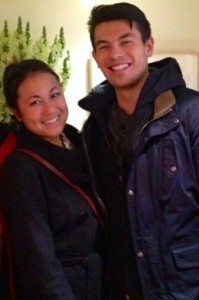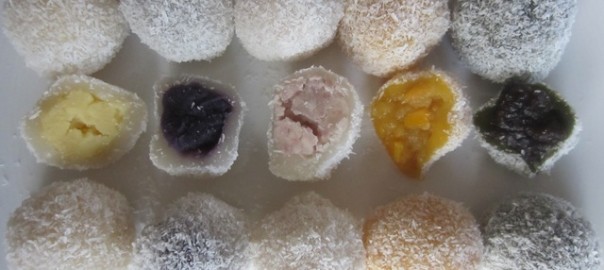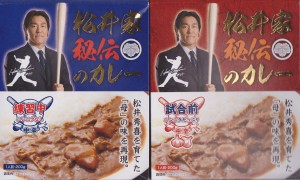Community Involvement on JET: Don’t Be Afraid to Start From Scratch
By Jayme Tsutsuse (Kyoto-fu 2013-2014), organizer for Cross-Cultural Kansai, seeking work opportunities in NYC starting August 2014!
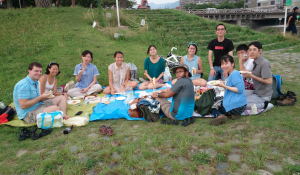
Cross-Cultural Kansai’s Summertime Picnic at the Kamogawa river in Kyoto, celebrating global identities with delicious food, beautiful weather, and amazing friends.
At the JET Program Tokyo Orientation last summer, we were all told to get involved in our communities as much as possible. It seemed like good advice, so I jotted it down in my list of goals, expecting this promise to somehow become less vague once I settled in.
I’m not sure how I envisioned it would happen. Obviously there wouldn’t be a community, gathered with open arms, ready welcoming me in when I arrived. Fair enough. But really, what were we supposed to do?
A friend suggested that I check out Meetup.com, and I was surprised to see how popular it was in Kansai (not nearly as expansive as New York or London, but still!). Every weekend, I’d join events in Osaka or Kyoto, and I never failed to fall deep into conversations with new friends about our backgrounds, where we came from, how it affects who we are today and where we want to go in the future. I loved listening to their stories. And the more I came across these stories, the more I thought about how great it would be to create a space for them, a community premised on sharing these parts of ourselves.
For the complete story, click here.
I’ll Make It Myself!: Rosemary-Orange Ricotta Muffins
L.M. Zoller (CIR Ishikawa-ken, Anamizu, 2009-11) is the editor of The Ishikawa JET Kitchen: Cooking in Japan Without a Fight. Ze works in international student exchange; writes I’ll Make It Myself!, a blog about food culture in Japan and the US; curates The Rice Cooker Chronicles, a series of essays by JETs and JET alumni on the theme of cooking/eating and being alone in Japan; and admins The JET Alumni Culinary Group on LinkedIn.
Can’t find ricotta in your grocery store in Japan? Never fear! It’s a piece of cake (muffin?) to make your own in Japan. Muffins work well in the moven, too.

JQ Magazine: Book Review — ‘Apparitions: Ghosts of Old Edo’
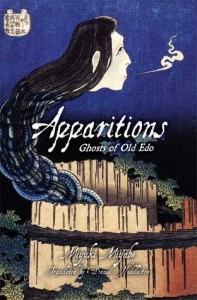
“Apparitions succeeds at not only giving historically accurate insight into the Edo period, but also delivers thought-provoking ghost stories that inspire fear and excitement with subtlety and expertly written dialogue and prose.” (Haikasoru)
By Julio Perez Jr. (Kyoto-shi, 2011-13) for JQ magazine. A bibliophile, writer, translator, and graduate from Columbia University, Julio is currently working at Ishikawa Prefecture’s New York office while seeking opportunities with publications in New York. Follow his enthusiasm for Japan, literature, and board gaming on his blog and Twitter @brittlejules.
Miyuki Miyabe is a Japanese author who writes widely popular fantasy, science fiction, and crime fiction for adults and young adults. Some of her works translated into English are Brave Story, ICO: Castle in the Mist, and The Book of Heroes. Published by Haikasoru last November, Apparitions: Ghosts of Old Edo is a collection of Miyabe’s short stories (translated by Daniel Huddleston) about pre-modern Japan depictions of ghosts, oni, and other supernatural events.
Apparitions includes nine short stories that are each unique but all so thoroughly engrossing that you can feel the immediacy of the narrator leaning in to deliver the chilling line foretelling the horrors yet to be revealed. Each of the stories captures the social hierarchy of the Edo period, which is a key element to illustrate in Japanese horror. One of the reoccurring aspects in Japanese ghost lore is an unbearably deep grudge that keeps a person’s spirit lingering after death. Edo society had a very rigid class system that is the source of frustration and resentment among characters, and this very resentment leads to vengeful ghost stories. This is why most ghosts in this genre are servants or women who are taking revenge on unjust masters, and insincere lovers of higher status. In this way, Japanese ghost stories are uniquely powerful in portraying the potential for wickedness in the human heart, whether it is the heart of the living or that of the vengeful dead. The supernatural dangers that appear in these stories all result from the cruel actions and thoughts of normal people that can and do occur every day. This is often exactly what is terrifying about these tales—not the ghosts, but the people.
Posted by Jayme Tsutsuse (Kyoto-fu, 2013-Present), job poster for JETwit and organizer of Cross-Cultural Kansai, seeking work opportunities in NYC starting in August 2014!
I recently returned to Kyoto after spending a week in New York City. Before my trip, I worried that I would experience what is called reverse culture shock, but shortly after returning to American soil, I realized the mistake in my worries. What I experienced wasn’t the culture shock of returning to a home that feels strangely between familiar and foreign. It was the culture shock of a completely novel experience.
It really didn’t take long after landing for this culture shock to set in. My boyfriend, Jeff, and I, both half-Japanese, born and raised in America, were riding an escalator up from JFK’s international arrivals lobby to the Airtram terminal. We were caught up in each other presence, having been apart for months, when suddenly, the lady on the downward escalator turned to us with a larger-than-life smile and enthusiastically called out, “Chinese“, waving her hand in our direction. We locked eyes with her, stunned, as she gradually disappeared down the escalator. Jeff and I stared each other up and down, searching for something that would have brought on the lady’s quick judgement. The man behind us rhetorically remarked, “What the hell was that about?”
The act itself wasn’t offensive or hurtful, but I could’t quite shake it from my thoughts. Granted a large international airport may be an easy place to act on an assumption that someone is foreign, but wouldn’t a simple hello suffice? Or Welcome to America if you must.
For months, I had been telling the people I met in Japan about America’s diversity – about how easy it is to blend in in the bigger cities, about how it is impossible to make judgements on whether or not someone is American. I’ve always claimed that on the subway in America, you can’t guess who is foreign on the basis of their race, appearance, language, or actions. But there we were in what’s said to be one of America’s most diverse cities, being incorrectly called out for our… ethnicity? nationality? identity?
L.M. Zoller (CIR Ishikawa-ken, Anamizu, 2009-11) is the editor of The Ishikawa JET Kitchen: Cooking in Japan Without a Fight. Ze works in international student exchange; writes I’ll Make It Myself!, a blog about food culture in Japan and the US; curates The Rice Cooker Chronicles, a series of essays by JETs and JET alumni on the theme of cooking/eating and being alone in Japan; and admins The JET Alumni Culinary Group on LinkedIn.
While searching for information on the 2014 sakura doughnut line-up (which appears not to be happening*), I stumbled upon this announcement from Mister Donut: the cronut is coming to Japan.
L.M. Zoller (CIR Ishikawa-ken, Anamizu, 2009-11) is the editor of The Ishikawa JET Kitchen: Cooking in Japan Without a Fight. Ze works in international student exchange; writes I’ll Make It Myself!, a blog about food culture in Japan and the US; curates The Rice Cooker Chronicles, a series of essays by JETs and JET alumni on the theme of cooking/eating and being alone in Japan; and admins The JET Alumni Culinary Group on LinkedIn.
This rich dessert showcases two of my favorite Japanese flavors for sweets together in a visually impressive cake.
I’ll Make It Myself!: Honey Cream Scones with Nuts
L.M. Zoller (CIR Ishikawa-ken, Anamizu, 2009-11) is the editor of The Ishikawa JET Kitchen: Cooking in Japan Without a Fight. Ze works in international student exchange; writes I’ll Make It Myself!, a blog about food culture in Japan and the US; curates The Rice Cooker Chronicles, a series of essays by JETs and JET alumni on the theme of cooking/eating and being alone in Japan; and admins The JET Alumni Culinary Group on LinkedIn.
Here’s an easy and delicious recipe you can make in your oven range in Japan!
I had extra cream from the Sailor Uranus cake, so I decided to try a cream scone recipe. Cream scones use heavy cream in place of the egg and butter, which makes them light and airy–and there’s no need to deal with cutting flour into cold butter. Very easy.
I’ll Make It Myself! Kickstarter: Amy’s Mochi (Seattle)
L.M. Zoller (CIR Ishikawa-ken, Anamizu, 2009-11) is the editor of The Ishikawa JET Kitchen: Cooking in Japan Without a Fight. Ze works in international student exchange; writes I’ll Make It Myself!, a blog about food culture in Japan and the US; curates The Rice Cooker Chronicles, a series of essays by JETs and JET alumni on the theme of cooking/eating and being alone in Japan; and admins The JET Alumni Culinary Group on LinkedIn.
Look at these luscious hand-made mochi! I found this Kickstarter via Have You Nerd? and, readers, I need this in my life. Amy’s Mochi is fundraising to cover the costs of starting up in Seattle – kitchen equipment, website, marketing, research and development – with the intent to sell them at weekly events (farmers’ markets) and/or pop-up shops. Kickstarter here: Amy’s Mochi by Amy Eam — Kickstarter. Ends March 28, 2014!
Posted by Benjamin Martin, a JET from 2008-2013 in Okinawa, publisher of the blog MoreThingsJapanese.com and author of Revenge of the Akuma Clan
(Tuttle).
This post is an excerpt from the original on my blog, here to help anyone in Japan who might be considering settling down. Like most people, I had no idea what I was getting into but figured the process might not be quite as straight forward as going to a local court and signing some papers… I don’t think Kume Island even has a court…
I did what most would do and googled it. The American Embassy site explains the process quite clearly for US citizens. I’m sure most other countries have similar information available for their expats. It gives all the basic information, and I went to my local town hall to confirm. Since I live in such a small community it was rather easy and quick to get everything I need, but unlike large cities the offices are not open 24/7.
The first step for Americans is filling out the Affidavit of Competency to Marry and having it translated (or translate it yourself). On a side note, the legal marriage is called nyuseki (入籍) in Japan. For me this was easy as I followed the example provided on the site above. One thing to watch out for is the part where you write your passport number and issuing local. For me it turned out to be the Department of State and not a city so I had to rewrite the form at the last-minute.
To get the forms notarized you have to make an appointment with the embassy, which are limited and cost $50. It was a pain (though the staff were very nice) and I had to make a special trip into the mainland to do it. With the added security you’ll want to give yourself plenty of time. You can’t even get to the gate without your appointment slip so don’t forget it. With the form in hand your work is done as far as preparations go.
Getting Married
 All you should need at the town (city) hall is your passport and the competency form (notarized English and Japanese translation). Then you can fill out the form and have your partner do the same. If your partner is Japanese they’ll need their own forms (such as family register) which they can get at their own local town or city hall. You’ll also want to decide if your partner will be changing their honseki (permanent residence) at that time or at a later date. For foreigners you just write your nationality (in Japanese).
All you should need at the town (city) hall is your passport and the competency form (notarized English and Japanese translation). Then you can fill out the form and have your partner do the same. If your partner is Japanese they’ll need their own forms (such as family register) which they can get at their own local town or city hall. You’ll also want to decide if your partner will be changing their honseki (permanent residence) at that time or at a later date. For foreigners you just write your nationality (in Japanese).
One good piece of advice I received and will pass on here is to go a day before you actually marry to have your forms checked over (you can get them in advance). Since the day you marry is often important in Japan, you can avoid having the date of marriage delayed due to a typo and re-entered form. As a foreigner, I filled in my name in Katakana and the rest in Japanese (be careful here, especially if you have a middle name. They originally tried to talk me into writing my middle and family name together, which would mean my wife would have to go by that rather than just Martin!). My significant other filled out the form in Japanese and had to fill out a separate form to take my name. Both forms are straight forward, though there’s a section about household work. For those of us who lived alone, it’s whatever work we were doing. For my partner it was the primary work of her father and mother. It’s something the person in charge can help you answer.
You’ll need two witnesses as well (remind them to bring their seals!). If everything is in order they’ll announce everything is alright and you’ll be legally married. You will also be able to get your notice of marriage certificates sometime after that (I got mine later that day).
All in all it was not a difficult process.. but you’ll see that (or read about it in a later post). It helped that we planned ahead and communicated with the town hall.
One thing to note is that when a Japanese person marries a foreigner they are removed from their family register and become a family of one. Until they have a child they are legally their own family (unless you become a Japanese citizen which does not happen automatically). That’s a big deal in Japan.
Also, if you’re reading this and you happen to be a wedding planner/cake maker/do everything so we don’t have to er/ in Japan willing to donate (cough cough) your services… let me know!
P.S. You might note this post is a bit lacking in any info on what happened around the form signing. Keep an eye on TBS’s Motemote99 TV show in Japan to see what really happened.
I’ll Make It Myself!: Uranus Planet Power, Make Up! (Sailor Moon Cake)
L.M. Zoller (CIR Ishikawa-ken, Anamizu, 2009-11) is the editor of The Ishikawa JET Kitchen: Cooking in Japan Without a Fight. Ze works in international student exchange; writes I’ll Make It Myself!, a blog about food culture in Japan and the US; curates The Rice Cooker Chronicles, a series of essays by JETs and JET alumni on the theme of cooking/eating and being alone in Japan; and admins The JET Alumni Culinary Group on LinkedIn.
The 2014 Fandom Birthday Cake Season kicks off with a little something from Sailor Moon:
I’ll Make It Myself!: Food Report: Sakura Season 2014
L.M. Zoller (CIR Ishikawa-ken, Anamizu, 2009-11) is the editor of The Ishikawa JET Kitchen: Cooking in Japan Without a Fight. Ze works in international student exchange; writes I’ll Make It Myself!, a blog about food culture in Japan and the US; curates The Rice Cooker Chronicles, a series of essays by JETs and JET alumni on the theme of cooking/eating and being alone in Japan; and admins The JET Alumni Culinary Group on LinkedIn.
In part 1 of this two-part(?) series, I take a look at Starbucks’ annual sakura “latte,” Häagen-Dazs’ rose and sakura ice creams, and something special from Seattle!
—-
First, I’m very jealous of you all in Japan enjoying or about to enjoy the sakura food! I like to follow food trends, so, for posterity, here are some foods from cherry-blossom season 2014. Most of these are from international brands and chains that localize their products for Japan.

Screenshot of the Starbucks Products Page (2/16/2014) See also here.
*****
Writer, researcher, and JET alumnus Matt Leichter (Saitama-ken ’03-’05) will give an encore performance of his lecture, “College Education: Certain Debt, Uncertain Income.” It will again be hosted by the Henry George School of Social Science in New York City. The event date is Wednesday, January 29, at 6:30 PM. The location is not the school’s normal address; instead it will be at:
NYC Seminar and Conference Center
71 West 23rd Street (corner of 6th Ave.)
New York, NY 10010
Here is the lecture’s abstract:
Soaring costs for education, together with limited job opportunities and stagnant wage growth, place substantial financial and psychological burdens on students.
Noted columnist and researcher Matt Leichter reviews tuition inflation, cuts in public funding and the business of lending to students. Mr. Leichter will also propose reforms to the system of financing college education.
Space is limited; please register to attend by emailing hgs.billy@gmail.com.
I’ll Make It Myself!: The Rosette of Versailles: Apple Custard Tart with Walnut Crust
L.M. Zoller (CIR Ishikawa-ken, Anamizu, 2009-11) is the editor of The Ishikawa JET Kitchen: Cooking in Japan Without a Fight. Ze works in international student exchange; writes I’ll Make It Myself!, a blog about food culture in Japan and the US; curates The Rice Cooker Chronicles, a series of essays by JETs and JET alumni on the theme of cooking/eating and being alone in Japan; and admins The JET Alumni Culinary Group on LinkedIn.
I’m a huge fan of Ikeda Riyoko’sThe Rose of Versailles (Beru Bara) fan, so how could I pass up a version of tarte bouquet de roses? You’ll need a lot of walnuts, some maple syrup, and some elbow grease, but this elegant tart can be made in your Japanese kitchen, too!
Around Japan in 47 Curries: Mrs. Matsui’s Ishikawa Slugger Sauce
Tom Baker (Chiba, 1989-91) is writing a 47-part series of posts on his Tokyo Tom Baker blog, in which he samples and comments on a curry from a different prefecture each time. Here’s an excerpt from his 16th installment, in which he tastes a facsimile of the home cooking that the most famous person from Ishikawa Prefecture grew up on.
Professional baseball player Hideki “Godzilla” Matsui was born in 1974 in the town of Negari, in Ishikawa Prefecture. Most mothers want their sons to grow up to be big and strong, but few succeed as dramatically Mrs. Matsui did. As a kid, he was already such a powerful right-handed hitter that the other boys wouldn’t play with him unless he switched to batting left-handed. He did – and still went on to become one of the top batters in the world.
There must have been something in his mom’s cooking. Maybe it was her curry…
Now that Godzilla is retired, he has taken to hawking a brand of curry called “Matsui-ke Hiden no Kare,” or the Matsui family’s secret curry. In a clever bit of marketing, there is garlic-free “renshu-chu” curry for “during training” and also “shiai-mae” curry, which is loaded with garlic, for “before the game.”
Read the full entry here.
*****
Writer, researcher, and ex-JET Matt Leichter (Saitama-ken ’03-’05) will be presenting “College Education: Certain Debt, Uncertain Income” at the Henry George School of Social Science in New York City on Friday, December 20, at 6:30 PM. Here is the abstract:
Soaring costs for education, together with limited job opportunities and stagnant wage growth, place substantial financial and psychological burdens on students.
Noted columnist and researcher Matt Leichter reviews tuition inflation, cuts in public funding and the business of lending to students. Mr. Leichter will also propose reforms to the system of financing college education.
The school is located in Manhattan on East 30th Street between Park Avenue and Lexington Avenue.

